The notion of the power of place suggests that place somehow has the potential to influence behaviour, attitudes, and beliefs. It has been widely used as a title for books, reports, websites and articles, usually with little or no further clarification of what is meant by either by place or by power, or how they connect. This post and a second one on political and economic power in place summarize the range of ways the idea has been interpreted in books, a few articles, and websites that refer to power and place in their titles. The illustrations should give some indication of how I think the interpretations are revealed in landscapes.
The main conclusion I have been able to draw is that the power of place is a versatile and adaptable idea with many different uses, few of which acknowledge any of the others. A second conclusion, which I have used as the criterion for separating my discussion of it into two posts, is that there are two distinctively different assumptions about how power operates through place. One regards power as an intrinsic quality of place: for instance in sacred sites power is seen a property of the place itself and is independent of human interventions. The other assumption treats places as conduits for expressing political and economic power, in other words, power is regarded as something that is given or ascribed to places in order to support anddemonstrate the authority of individuals, institutions or communities.
Several of the accounts I have read raise important questions about the ways power is exercised in place that I think are worth noting but I do not pursue here because they either have to be asked of particular places, or apply to the politics of place (a topic I expect to discuss in a future post). These questions are:
• Which individuals or groups possess, convey or promote the power of place?
• How is this power exercised – coercion, negotiation, regulation, or persuasion and education?• • On whose behalf is the power used? Who benefits from or is disadvantaged by the power of place?
• How is the structure and shape of a place (and its landscape) a reflection of the power structure of the society that produced and maintains it?
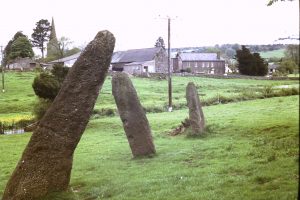
Three Neolithic standing stones in the village of Trellech, Monmouthshire, Wales. They are thought to mark a sacred site whose spirits and power have long departed.
The Intrinsic Power of Sacred Places.
Sacred places, Jacob Kinnard (2014) writes in Places in Motion, seem to have “power fallen from the sky.” Or perhaps the power could have emerged from the ground. Either way it is intrinsic, not necessarily obvious to everyone and waiting to be revealed to or discovered by those who are sufficiently in tune with their surroundings to recognize it. Martin Gray has suggested that the sacred power of place manifests “the presence of the miraculous” and suggests that it was discovered by our ancestors who were more in tune with the energy of the vital earth than us. They sometimes marked ancient sacred places, for instance with standing stones or mounds, perhaps as a means to disclose their power to others, and some of these remain to this day, although their purpose has been long forgotten and the energy they mark is eludes most of us.
Kinnard’s book is about this fluidity of the identities of sacred places such as temples and pilgrimage sites. As with Stonehenge, Tikal or the Camino del Santiago de Compostela their original sacred power faded as the cultures that created them waned. In spite of this the fact that so many former sacred sites are tourist attractions indicates that they still have the power to inspire awe. James Swan (1991) declares that: ”Modern psychology and design have tossed aside such ideas as places of power, but our bodies and minds still hear their call and respond to them.” And intimations of the importance of the intrinsic power of place are apparent in the continuing use of the ancient Chinese techniques of geomancy and Feng Shui that are used to survey positive and negative energies flowing through place and landscape, and which are selectively employed to direct appropriate and propitious ways to situate buildings and facilities such as cemeteries.
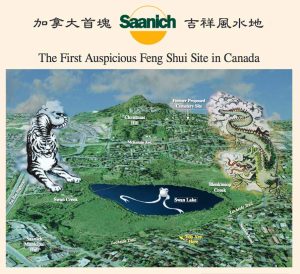

The first auspicious Feng Shui site in Canada is at Christmas Hill, just north of Victoria, British Columbia, and is shown in this sign at a viewpoint overlooking the site as flanked by the positive forces of the green dragon and white tiger. It was identified in the 1890s and was probably intended as a cemetery, but opposition from local communities prevented this and the Chinese cemetery was located at another auspicious site about ten kilometres away. Feng Shui requires training in the skills of geomancy to identify sites that are auspicious an inauspicious, skills that at one time would have been associated with priests. Now Feng Shui offers business opportunities for consultants, as indicated by the World of Feng Shui “good luck store” at Vaughan Mills shopping centre north of Toronto.
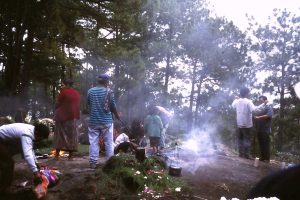
A curing ceremony at a sacred place near Chichicastenango in Guatemala that is thought to have been used continuously for more than a thousand years. Photo taken 1997.
For indigenous people in North America and elsewhere this sort of understanding of the intrinsic energy and power of places remains vital. Vine Deloria and Daniel Wildcat (2001) have written that: “The Indian world can be said to consist of two basic experiential dimension that, taken together, provide sufficient means of making sense of the world. These two concepts were place and power, the latter perhaps better defined as spiritual power or life force.“ Power is the living energy that inhabits the universe – a qualitative dimension shaping thoughts, desires, habits, actions and institutions, and it operates for the most part without us thinking about it. Place is concrete and palpable, where one discovers his or her personality in the context of that living energy. Native people, they suggest, possess personalities and culture born of places (pp141-144). [For a related but slightly different angle see Michael Marker’s The Power of Place as Methodology in Indigenous Research].
 The intrinsic power of place is sometimes experienced by individuals as an affirmation of their religious convictions or as life changing epiphanies. In The Varieties of Religious Experience the philosopher William James (p. 71) quotes an account of someone’s experience on the summit of a high mountain: “I looked over a gashed and corrugated landscape extending to a long convex of ocean that ascended to the horizon…What I felt was a temporary loss of my identity that was accompanied by an illumination of deeper significance than I had previously attached to life. It is in this that I can say that I have enjoyed communion with God.” Paul Klee, the artist associated with the Bauhaus had a similar, though secular experience when he witnessed a moonrise over a town in North Africa just before World War One. It was a theme that recurred in his art for much of the rest of his life, such as this painting called “Chosen Site” from 1927.
The intrinsic power of place is sometimes experienced by individuals as an affirmation of their religious convictions or as life changing epiphanies. In The Varieties of Religious Experience the philosopher William James (p. 71) quotes an account of someone’s experience on the summit of a high mountain: “I looked over a gashed and corrugated landscape extending to a long convex of ocean that ascended to the horizon…What I felt was a temporary loss of my identity that was accompanied by an illumination of deeper significance than I had previously attached to life. It is in this that I can say that I have enjoyed communion with God.” Paul Klee, the artist associated with the Bauhaus had a similar, though secular experience when he witnessed a moonrise over a town in North Africa just before World War One. It was a theme that recurred in his art for much of the rest of his life, such as this painting called “Chosen Site” from 1927.
Intrinsic power can also be a property that some places acquire because of what happened there. This is true of many sites of pilgrimage, of Jerusalem and Mecca, but also of places that have experienced profoundly tragic events, such as the battlefields of World War One and Ground Zero in Manhattan.
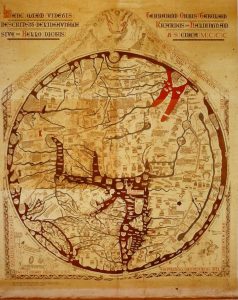
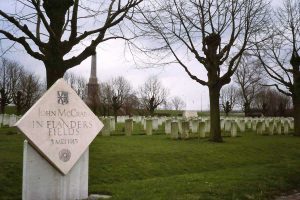
On the left is the Hereford Map of the World, dating from about 1300, that shows Jerusalem as the centre of the world; the Red Sea is top right, the Mediterranean is the T-shape in the centre and bottom, and the British Isles are bottom left. The symbolism that the power of Christianity spreads out from Jerusalem is explicit. On the right is the World War One cemetery in Flanders which is the burial place of John McCrae, the author of the poem “In Flanders Fields” that has defined the way that World War One is remembered in Britain and Commonwealth countries. Many places associated with great tragedies and loss of life have acquired intrinsic power of place.
The Intrinsic Power of Geographical Place Diversity
This is a more rational notion of the power of place. The fact that Geography has often been defined as the study of places has presumably contributed to an assumption by some geographers that place is powerful because places are different, for example in a video instructional series for high school and college students titled The Power of Place, which provides case studies of 25 distinctly different cities and regions around the world.
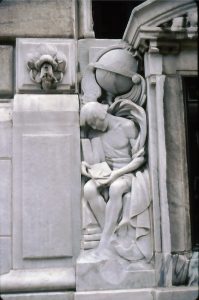
Scupture of a geographer at work, Cleveland, Ohio
A more explicit and forceful argument is made by geographer Harm de Blij in his 2009 book The Power of Place – Geography, Destiny and Globalization’s Rough Landscape, in which he takes issue with economic arguments about the spatial flattening of the world through global trade and electronic communications. He argues that “the power of place still holds us in its thrall” because “the confines of place (the rugged terrain of the world’s environmental, cultural, social, economic and political geographies) continue to impose severe limits on human thought and action, engendering inequalities…so evident that no flat-world… postulations can wish them away.”
For de Blij the power of place lies in the persistence of intrinsic geographical differences that are expressed, for instance, in regional patterns of health and sickness, wealth and poverty, religion, culture, language and environment. A similar acknowledgement of the potency of regional diversity has been made in art. A 2017 exhibition at the High Museum of Art in Atlanta on The Power of Place in American Art 1915-1950 showed 200 works by artists who took inspiration from their surroundings in different areas of the United States, artists such as Georgia O’Keeffe, Andrew Wyeth and Ansell Adams.
The Intrinsic Power of Place Environments
There seem to be two very different strands of thought about how the intrinsic power of places functions. One is the cause-effect argument summarized in the title of Winifred Gallagher’s 1993 book The Power of Place: How our surroundings shape our thoughts, emotions and actions. This is an updated version of the old refrain of environmental determinism, which holds that national and even personal characteristics are directly influenced by the natural environment, especially landforms and climate – for instance, the temperate climates of North West Europe were responsible for the strong work ethic and rational thought that justified imperial expansion into regions where hot climates led to laziness and indolence. Gallagher is rather more subtle than this. She does draw on some scientific evidence to support her arguments, and acknowledges the value of geomancy and Feng Shui. Nevertheless, invoking the power of the natural environments of particular places and regions as something that shapes thoughts and actions does run close to the sort of thinking that that contributed to the rise of National Socialism and genocide in World War 2, and more generally to racism and ethnocentrism. It is a way of thinking that is best avoided.
Nevertheless, environmental differences between places cannot be entirely ignored, as Harm de Blij makes clear in his account of the geographical power of place, and as we know from ecological diversity. The point is to avoid understanding them as simple causes and to understand them as the products of complex interactions between people and natural circumstances that have many different possible outcomes.
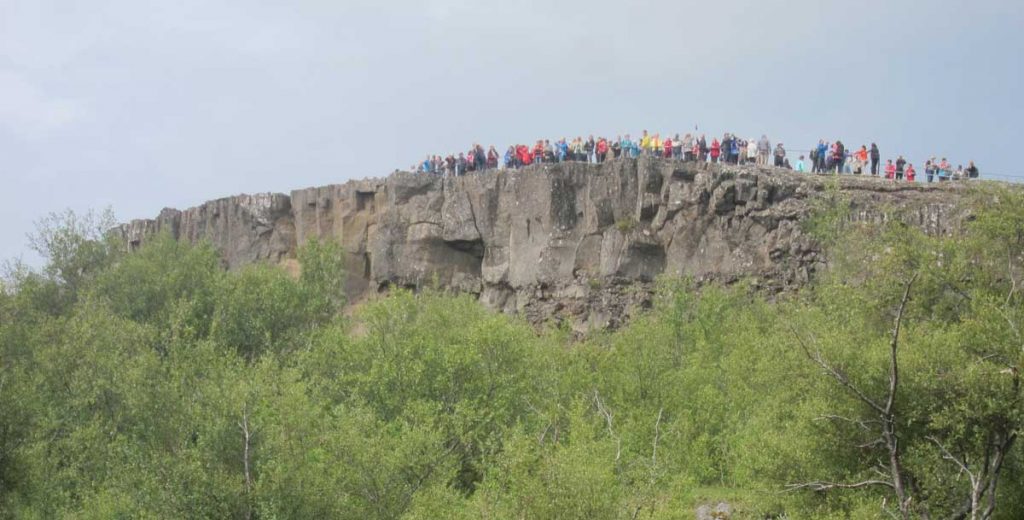
Tourists at Thingvellir in Iceland. This World Heritage Site is the boundary of the North American and Eurasian tectonic plates, a place where the mid-Atlantic rift is pulling apart, and the place where the Althing, considered by some to be the first democratic parliament, met from 930 A.D. to 1798. An indication of the intrinsic power of geographical place is that so many different types of places have the power to attract tourists. Photo 2016.
An important aspect of natural environments is that ecosystems are intrinsically distinctive because of their relationship to local geology, soils and climate. Proposals for sustainability, conservation, and the expansion of local food supply have to acknowledge the distinctiveness of place environments if they are to be successful. One solution simply will not work everywhere. What is appropriate for the ecosystems of the moors of Scotland has little relevance for the temperate rain forests of the Pacific North West in North America or the deserts of North Africa. Furthermore, conservation strategies have to take into account local economic and cultural circumstances. This is the basis for the proposal in the journal Biological Conservation that approaches to conservation and sustainability need to leverage that the power of place through citizen science. In other words the involvement of well-informed local citizens is needed to achieve effective decision-making for conservation.
Protecting the Intrinsic Power of Place
Many heritage organizations seem to share the view that the power of place, by which they usually mean some combination of local landcape distinctiveness and historical character, is under threat. For example, the Campaign to Protect Rural England has a report Recharging the Power of Place: Valuing Local Significance. The notion of the power of place is not discussed explicitly in this but the concern is that old places had character, depth and promoted a feeling of belonging, and these are being undermined by new developments that tend to “disconnect people from the places around them as well as places from their past.”
In the United States the Trust for Public Land, which “creates parks and protects land for people, ensuring healthy livable communities for generations to come,” had a 2015 donation campaign entitled The Power of Place that raised funds for parks, playgrounds and special places, and preserved 568,000 acres for public access. In other words and in this case, the power of place involves not only undertaking concrete actions in specific contexts, including fund-raising to provide or improve public spaces, but also by inference the great social value of public amenities such as parks and playgrounds.

This image of the White Horse of Uffington in southern England is on the side of National Trust vehicle parked at the site of the actual White Horse, a 110 m long, prehistoric, stylised image of a horse carved into a chalk hillside. Its original significance is unknown but the carving has been maintained for many centuries, presumably by people who wanted to preserve it.. As the slogan on the side of the truck indicates, the National Trust has now assumed responsibility for protecting its intrinsic power of place. Photo taken 2016.
References
•Annenberg Learner and Teacher Resources The Power of Place: Geography for the 21st Century, accessed 2017 https://www.learner.org/resources/series180.html
•de Blij, Harm 2009 The Power of Place – Geography, Destiny and Globalization’s Rough Landscape Oxford University Press
•Campaign to Protect Rural England, 2006 Recharging the Power of Place: Valuing Local Significance, accessed 2017 http://www.cpre.org.uk/resources/housing-and-planning/planning/item/1896-recharging-the-power-of-place
•Deloria, Vine and Daniel Wildcat 2001 Power and Place: Indian Education in America, American Indian Graduate Center, Golden, Colorado
•Gallagher, Winifred 1993 The Power of Place: How our surroundings shape our thoughts, emotions and actions, Poseidon Press, New York
•Gray, Martin The Power of Place: sacred Sites and the Miraculous accessed 2017 https://sacredsites.com/martin_gray/publications/the_power_of_place_sacred_sites_and_the_presence_of_the_miraculous.html
•High Museum of Art in Atlanta 2017 Cross-Country: The Power of Place in American Art 1915-1950, an exhibition summarized at https://www.high.org/exhibition/cross-country/, accessed 2017
•James, William, 1961. The Varieties of Religious Experience. New York: Collier Macmillan.
•Kinnard , Jacob 2014 Places in Motion: The Fluid Identities of Temples, Energies and Pilgrims, Oxford University Press
•Marker, Michael 2017 The Power of Place as Methodology in Indigenous Research accessed 2017 http://educ.ubc.ca/critical-dialogues-seminar-the-power-of-place-as-methodology-in-indigenous-research
•Newman, G. et al, 2016 “Leveraging the power of place in citizen science for effective conservation,” Biological Conservation Vol 208, accessed 2017 at http://www.sciencedirect.com/science/article/pii/S0006320716302841
•Swan, James (ed) 1991 The Power of Place: Sacred Ground in Natural and Human Environments Quest Books, Wheaton Illinois
•Trust for Public Land 2015 The Power of Place, accessed 2017 https://www.tpl.org/power-of-place#sm.0000bp5oj1egoeitu3f2k5q43clhz